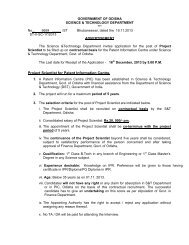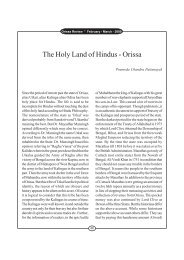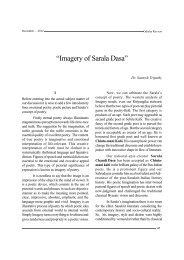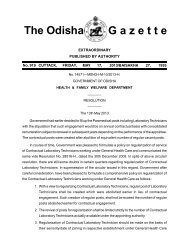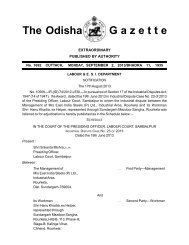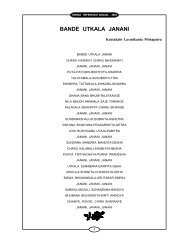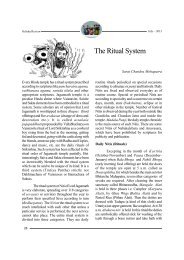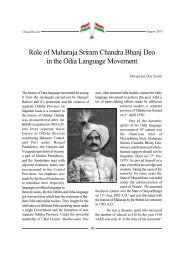Goddess Kichakeswari Temple at Khiching
Goddess Kichakeswari Temple at Khiching
Goddess Kichakeswari Temple at Khiching
You also want an ePaper? Increase the reach of your titles
YUMPU automatically turns print PDFs into web optimized ePapers that Google loves.
September - October 2011<br />
Orissa Review<br />
<strong>Goddess</strong> <strong>Kichakeswari</strong> <strong>Temple</strong> <strong>at</strong> <strong>Khiching</strong><br />
Balabhadra Ghadai<br />
150 Kms away from Baripada, the headquarters<br />
of Mayurbhanj District and 25 Kms from<br />
Karanjia, the Sub-Divisional headquarters is<br />
situ<strong>at</strong>ed <strong>at</strong> modern <strong>Khiching</strong> (Khijinga Kotta), the<br />
ancient capital city of the Bhanja Kings from about<br />
the middle of the ninth<br />
century AD. to the middle<br />
of the twelfth century AD.<br />
It lies between 21.50<br />
degree north l<strong>at</strong>itude and<br />
85.50 degree east l<strong>at</strong>itude<br />
near the confluence of the<br />
rivers Khairibhandana and<br />
Kantakhairi. This<br />
wonderful land of<br />
fascin<strong>at</strong>ing beauty and a<br />
long tradition of art and<br />
architecture, exquisite<br />
temples and historical<br />
monuments speak volumes<br />
of its past glory.<br />
The religious<br />
history of the Bhanja Kings<br />
of <strong>Khiching</strong> is<br />
cosmopolitan, for<br />
Buddhism, Jain ism and other cults flourished side<br />
by side with Hinduism. The worship of the<br />
Panchadev<strong>at</strong>a, namely Vishnu, Siva, Surya,<br />
Ganap<strong>at</strong>i and Sakti were widely prevalent here.<br />
The Bhanja Kings were devout worshippers of<br />
Sakti as borne by the fact th<strong>at</strong> <strong>Kichakeswari</strong><br />
(Khijingeswari) or Chamunda was the tutelary<br />
deity of the Bhanja dynasty. Several images of<br />
Durga, Mahisasuramardini and Saptam<strong>at</strong>ruka<br />
bear evidence of the<br />
popularity of Saktism.<br />
The existing temple of<br />
<strong>Goddess</strong> <strong>Kichakeswari</strong> is<br />
not the original one. It was<br />
during the rule of Maharaja<br />
Purna Chandra Bhanja Deo<br />
th<strong>at</strong> a system<strong>at</strong>ic<br />
excav<strong>at</strong>ion of the Thakurani<br />
compound was first started<br />
by Raibahadur Rama<br />
Prasad Chand, who had<br />
been deputed for the<br />
purpose by Sir John<br />
Marsal <strong>at</strong> the request of the<br />
Maharaja. Mr. Chand<br />
during excav<strong>at</strong>ion of the<br />
Thakurani compound in<br />
1922-24 came across the<br />
found<strong>at</strong>ion of a gre<strong>at</strong> temple<br />
which measured 35’ square <strong>at</strong> the base.<br />
This found<strong>at</strong>ion represented an old<br />
temple’s vestiges which had long since<br />
27
Orissa Review September - October 2011<br />
disappeared in the limbo of history. The install<strong>at</strong>ion<br />
of <strong>Goddess</strong> <strong>Kichakeswari</strong> on the ruins on an<br />
earthen pl<strong>at</strong>form was an impromptu affair<br />
accomplished <strong>at</strong> a time when the circumstances<br />
were quite unfavorable. Chanda observed two<br />
things: (i) the old temple had enshrined a life-size<br />
image of Hara with many other life- size images<br />
as Parsadev<strong>at</strong>as / Parivaradev<strong>at</strong>as and<br />
Dwarapals (now preserved in the site Museum)<br />
and (ii) the temple had collapsed due to weak<br />
found<strong>at</strong>ion. It was quite unbearable for the Bhanja<br />
ruler, Maharaja Purna Chandra th<strong>at</strong> the family<br />
deity was being worshipped in a provisional<br />
structure. There was no dearth of m<strong>at</strong>erial.<br />
Standing on the ruins of the Thakurani’s compound<br />
it was quite n<strong>at</strong>ural for the king to search for and<br />
think of the possible ways and means to restore<br />
the monuments besides providing a temple for the<br />
family deity. The Report on the Administr<strong>at</strong>ion of<br />
Mayurbhanj 1923-24, p.81 para 5 clearly<br />
records.<br />
“Found<strong>at</strong>ions of the original temple in<br />
which the God Siva was enshrined have been<br />
traced. Over the shrine of the original temple<br />
stands small brick-built temple wherein the<br />
<strong>Goddess</strong> <strong>Kichakeswari</strong> is <strong>at</strong> present enshrined.<br />
At the request of the people of the locality, the<br />
Maharaja (Purna Chandra Bhanj Deo) with his<br />
brother, the Chhotrai Saheb (Pr<strong>at</strong>ap Chandra<br />
Bhanj Deo) visited the shrine on the 24th January<br />
1924 and promised to restore the original temple.”<br />
In his conserv<strong>at</strong>ion note J.A. Page,<br />
Assistant Superintendent of the Archaeological<br />
Survey of India, Central Circle, suggested th<strong>at</strong><br />
the brick-built shrine of the Thakurani be removed<br />
from the compound as its ugliness did not conform<br />
to the surroundings. The demolition of the shrine<br />
would make construction of a new shrine<br />
imper<strong>at</strong>ive, he wrote. At the request of the<br />
Maharaja the Director General of Archaeology<br />
asked Mr. Page to make a plan for a simple<br />
structure of Indo-Aryan style. Since it was<br />
decided to use the doorjamb, door lintel and three<br />
images on the three niches of the old temple in<br />
the proposed new temple, the Khandiya deula<br />
(ruined temple) was demolished. Therefore, the<br />
idea to arrange a plan / design was mooted. The<br />
weak found<strong>at</strong>ion of the old temple was considered<br />
unsuitable for erecting the proposed new<br />
structure. The Administr<strong>at</strong>ive report of 1933-34<br />
informs th<strong>at</strong> the Maharaja was in favour of<br />
building a temple of <strong>Khiching</strong> style.<br />
In 1924-25 the construction of a new<br />
temple for <strong>Goddess</strong> <strong>Kichakeswari</strong> was proposed<br />
and accordingly J.A. Page gave a plan of Indo-<br />
Aryan style of temple design. As the style of the<br />
<strong>Khiching</strong> temples were different from th<strong>at</strong> of<br />
temples of Bhubaneswar, it was decided by the<br />
Maharaja to have a design of a temple of <strong>Khiching</strong><br />
style. The first thing the Maharaja did was to build<br />
a site museum for the better preserv<strong>at</strong>ion of<br />
sculptures for which a large plot of land was<br />
acquired to extend the temple compound and to<br />
fence it with wire. The non-descript brick temple<br />
of the <strong>Goddess</strong> was demolished and removed<br />
from the compound. The <strong>Goddess</strong> was put in a<br />
newly constructed shed till a proper temple was<br />
built.<br />
Due to tragic de<strong>at</strong>h of Maharaja Purna<br />
Chandra Bhanj Deo in 1928 the progress in the<br />
m<strong>at</strong>ter was delayed for a few years and ultim<strong>at</strong>ely<br />
Babu Sailendra Prasad Bose, the Archaeological<br />
Supervisor of the department made the design<br />
on the d<strong>at</strong>a obtainable from the existing temple<br />
and his design finally received the approval of the<br />
Maharaja. This challenge of Mr. Bose was<br />
formidable one demanding hard work, dedic<strong>at</strong>ion,<br />
perfect skill, integrity and leadership. The work<br />
for the temple began before the close of the 1933-<br />
34 financial years and completed by the end of<br />
28
September - October 2011<br />
1941. The deity was installed on 14th March<br />
1942 amidst pomp and ceremony. The height of<br />
the temple measured 68’ above the ground level<br />
and a sum of Rs.80,000/- was spent in its<br />
reconstruction and conserv<strong>at</strong>ion.<br />
The temple in its restored form also<br />
adheres to the Orissan Rekha type of architecture<br />
with a peculiarity of its own i.e. absence of a<br />
porch. It is otherwise a Panchar<strong>at</strong>ha temple<br />
consisting of five pages (Pilasters). The sanctuary<br />
is square in the ground plan, rectangular parallelopiped<br />
from above the base, and surrounded by a<br />
curvilinear tower. The original temple was built in<br />
the tenth century A.D. and as such it is almost a<br />
contemporary of the Brahmesvar and Lingaraj<br />
temples <strong>at</strong> Bhubaneswar.<br />
The image of <strong>Kichakeswari</strong>, now being<br />
worshipped <strong>at</strong> the main temple <strong>at</strong> <strong>Khiching</strong> is the<br />
grim figure of the <strong>Goddess</strong> Chamunda. This figure,<br />
although broken in three parts has been joined<br />
together and inspires awe and fear among the<br />
devotees. According to N.N Vasu this image is<br />
one of the forms of Bhima, the emaci<strong>at</strong>ed body<br />
disclosing a hideous skeleton with the bones and<br />
ribs all laid bare.<br />
Orissa Review<br />
The <strong>Goddess</strong> is se<strong>at</strong>ed on a lotus issuing<br />
from the naval of Purusa. Over the head and back<br />
of the <strong>Goddess</strong> rises the figure of Airav<strong>at</strong>a. On<br />
other side of her crown there is a serpent with<br />
uplifted hood. Of the eight hands the left ones are<br />
in Abhaya and Varada poses and hold rosaries<br />
and a head where as two right hands hold a<br />
dambaru and a cup, the other two being<br />
completely damaged.<br />
Thus the temple of <strong>Goddess</strong><br />
<strong>Kichakeswari</strong> is a priceless embodiment of<br />
superb charm and inimitable grace, and occupies<br />
a significant place among the famous monuments<br />
of Orissa like Konark, Puri and Bhubaneswar as<br />
a sacred sanctuary of religious activities and the<br />
<strong>Goddess</strong> <strong>Kichakeswari</strong> in the form of eightarmed<br />
Chamunda of Sakta pantheon stands<br />
gloriously betokening the heyday of royal dignity<br />
and aristocracy.<br />
Balabhadra Ghadai, Principal, M.K. College, <strong>Khiching</strong>,<br />
Mayurbhanj.<br />
Genius does not argue, it cre<strong>at</strong>es. – Rabindran<strong>at</strong>h Tagore<br />
29



